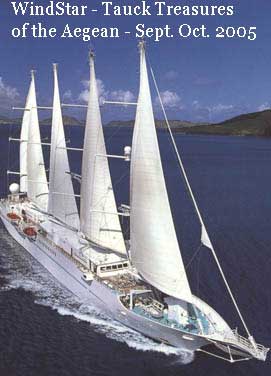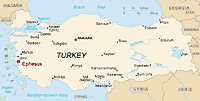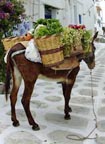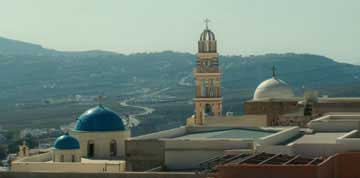 |
Treasures of the Aegean Tauck World Discovery and WindStar Cruises September 21 - October 4, 2005 Tauck's 251st Treasures of the Aegean Southbound Tour began on September 21, 2005 with 43 guests in our group. I planned this trip with my old friend Judy. Our husbands stayed at home. I left from Myrtle Beach, SC and Judy left from her home in Roanoke, VA. We met up in the in the Atlanta airport amd began our exciting journey! As we arrived in Istanbul, you can imagine the ooh's and ahh's as we were greeted with many views like this and this. Here's a view from our hotel room for the first 3 nights - Swissotel The Bosporus. Meet our guide in Turkey, Umur Cakar! I think I can speak for our entire group when I say how very much we enjoyed Umur's professionalism, knowledge of the area, sense of humor, and love of his country. What a great guy! Here's another photoof Umur taken on the first day of our tour. |
||||||||||||||||||||||||||||||||||||||||||||||||||||||||||||||
|
Here's the Topkapi Palace Museum, the imperial seat of the Ottoman Empire. For more information and photos, heres the link to the Topkapi Museum Istanbul's skyline is embellished with slender minarets and the imposing domes of more than 450 mosques. The mosques not only immortalize their architects, but are also a treasury of the best examples of Turkish rugs, tiles, marble, and woodwork. must admit, Turkey has never been high on my list of places to visit for whatever ideas I may have held. I was absolutely blown away by this country! It is unbelievably clean and there are so many things to see. I feel like we just touched the tip of the iceberg. Turkey is a place like no other. The earliest civilization in the land that is modern Turkey began over 9,000 years ago and developed cities can be seen as far back as 2,000 BC. Turkey’s unique geographical location has made it a crossroads of European, Middle Eastern, and East Asian cultures throughout the whole of human history. Its rich tradition is matched by a welcoming population and an immense and diverse beauty. On our second evening in Istanbul, we had dinner along the Bosporus. Istanbul's 13 million population spans two continents - Europe and Asia. In the heart you'll find the Bosporus Strait - the Black Sea, the Sea of Marmara and the Golden Horn. Here's a view of the bridge, and a toast with new friends, Bud, Margie, myself and Linda. Basilica Cistern - The city of Istanbul is surrounded by water - the Black Sea, the Bosphorus, and the Sea of Marmara, so its aqueducts and reservoirs predate the Roman era, and the water has to be brought from lakes. The Medusa heads, (another shot of Medusa) were part of the pillars that support the roof. One is sideways, another is upside down. Medusa of Greek legend, has hair snakes, and blue eyes you must not look into. The evil eye can turn you to stone. We saw the blue eye in tourist shops in Istanbul and the Greek Islands as well. The Blue Mosque (Sultan Ahmed I) Mosque was deliberately sited to face Hagia Sophia, to demonstrate that Ottoman and Islamic architects and builders could rival anything their Christian predecessors had created.The two buildings comprise a unique historical and architectural precinct. The Blue Mosque was built between 1609 and 1616 by order of the Sultan Ahmed I, after whom it is named. At its lower levels the interior of the mosque is lined with more than 20,000 handmade ceramic tiles, made at Iznik (the ancient Nicaea). Its upper levels are painted. More than 200 stained glass windows with intricate designs admit natural light, today assisted by chandeliers. The decorations include verses from the Holy Koran, many of them made by Seyyid Kasim Gubari, regarded as the greatest calligrapher of his time. The floors are covered with carpets, which are donated by the faithful and are regularly replaced as they become worn. Someone asked the placement of strings of lights not far above our heads across the mosque. We were told they are placed low to help us to not feel insignificant." Our group with local guide Sheila, was taken at the ancient Hippodrome, the scene of chariot races and the center of Byzantine civic life. It is the area that is now in front of the Blue Mosque. |
|||||||||||||||||||||||||||||||||||||||||||||||||||||||||||||||
 |
|||||||||||||||||||||||||||||||||||||||||||||||||||||||||||||||
| Judy and I had lunch here The Asian side of Istanbul Here's our group photo! |
Apple Tea Linda Near the Hotel - Istanbul |
||||||||||||||||||||||||||||||||||||||||||||||||||||||||||||||
| The Istanbul Grand Bazaar (photos just below) was the only place in Istanbul that I did not enjoy. I successfully managed not to buy anything but an Evil Eye bracelet for a friend. You'll be reminded of Tales of the Arabian Nights in this colossal bazaar under one roof. Anything and everything under the sun is on sale and nothing is priced because the locals like to bargain. If bargaining appeals to you, you will think you are in heaven! This labyrinth of streets and passages houses more than 4,000 shops, and because of its immense size, it is not a place to wander alone for fear of becoming hopelessly lost.
Locals shop at the Spice Bazaar - (inside view) where all items are priced as marked. While we were told that there is usually no barganing, we did find several merchants who encouraged us to offer a price. The aromas of cinnamon, caraway, saffron, mint, thyme and every other conceivable herb and spice are enticing and once again, you are reminded of the mystical East |
|||||||||||||||||||||||||||||||||||||||||||||||||||||||||||||||
 |
Grand Bazaar - Street view Grand Bazaar - Inside |
||||||||||||||||||||||||||||||||||||||||||||||||||||||||||||||
| Here's a great photo of Margie and Jerry in the bus! | |||||||||||||||||||||||||||||||||||||||||||||||||||||||||||||||
| The first day on the WindStar was spent cruising the Dardanelles, 40 miles wide, connecting the Aegean Sea with the Sea of Marmara and separating the Gallipoli peninsula of European Turkey from Asian Turkey. We passed the site ofthe Battle of Gallipoli (in 1915), Here's a photo I took from the WindStar | |||||||||||||||||||||||||||||||||||||||||||||||||||||||||||||||
 |
Ephesus (click map on left to enlarge) is home to some truly amazing ruins, as you see from the photos below. It is the home of the Temple of Artemis, one of the Seven Wonders of the Ancient World. In 262 AD it was destroyed by the Goyhs and never rebuilt. All that remains today is one pillar, standing alone in a field. Where's Ephesus? Click the map on the left to enlarge. For a short history, click here. | ||||||||||||||||||||||||||||||||||||||||||||||||||||||||||||||
| Ephesus | Ephesus Museum | Ephesus | Ephesus Museum | Ephesus: Me (L) and Judy (R) | |||||||||||||||||||||||||||||||||||||||||||||||||||||||||||
| Ephesus | Ephesus | ||||||||||||||||||||||||||||||||||||||||||||||||||||||||||||||
| Kusadasi - Our group enjoyed a delightful lunch before viewing handmade Turkish rugs which were purchased by several people in the showroom.It was fascinating to watch rugs being made. Here's a photo of some of our group getting upclose and personal with their future rugs! | |||||||||||||||||||||||||||||||||||||||||||||||||||||||||||||||
 |
Rhodes, Greece and Lindos. Judy and I rode a burro (Judy in front) to the Acropolis of Lindos! I rode the burro back down! The Rhodes Acropolis dominated the western and highest part of the city. It was not fortified like most ancient acropoleis. It consisted of a monumental zone with Sanctuaries, large temples, public buildings and underground cult places. The buildings were built on stepped terraces supported by strong retaining walls. It was "full of fields and groves", in the words of the 2nd c. AD orator Ailios Aristides. The style of the Hellenistic architecture on the Acropolis of Rhodes was perfectly conveyed by the combination of natural beauty and artificial transformations. The buildings on the Acropolis date to the Hellenistic and Late Hellenistic periods (3rd-2nd c. BC). | ||||||||||||||||||||||||||||||||||||||||||||||||||||||||||||||
|
Photos below of Rhodes, Greece - The Acropolis, and the charming old town of Lindos:
|
|||||||||||||||||||||||||||||||||||||||||||||||||||||||||||||||
 |
Acropolis | Rhodes - Lindos from WindStar | |||||||||||||||||||||||||||||||||||||||||||||||||||||||||||||
| Acropolis | Lindos | ||||||||||||||||||||||||||||||||||||||||||||||||||||||||||||||
| Lindos | Lindos | ||||||||||||||||||||||||||||||||||||||||||||||||||||||||||||||
| Bodrum and the Turkish Coast. The following photos are delightful (if the photographer may say so herself!) The resort town of Bodrum was built upon the ancient city. We visited St. Peter's Castle and the tomb of Mausolos, another of the seven wonders of the world. You'll see that Umur took his role as Tour Director seriously in photos below. | |||||||||||||||||||||||||||||||||||||||||||||||||||||||||||||||
| Bodrum - port | Bodrum -Umur | Bodrum-Umur again! | |||||||||||||||||||||||||||||||||||||||||||||||||||||||||||||
| Judy and I -WindStar in background | Flags | Bodrum - Turkish flag | |||||||||||||||||||||||||||||||||||||||||||||||||||||||||||||
 |
Belly Dancer teaching Jerry the moves on the WindStar. | ||||||||||||||||||||||||||||||||||||||||||||||||||||||||||||||
| Bodrum - a beautiful view of our ship, the Wind Star | |||||||||||||||||||||||||||||||||||||||||||||||||||||||||||||||
| Bodrum Tomb Chamber | Store front | ||||||||||||||||||||||||||||||||||||||||||||||||||||||||||||||
| We had some spectacular views as the ship approached Santorini shortly after sunrise. I'm sure that all of you, like me, have seen photos in every travel magazine of the famous blue domes and white buildings. Santorini does not disappoint. For some reason, I thought Santorini would look a lot like the Isle of Capri...but I was wrong. In ancient time - around 1500 BC - Santorini was the victim of an enormous volcano eruption. History says that the explosions created huge waves which washed the shores of the surrounding islands and Crete. The consequence of is that a part of the island sank and the earthquakes destroyed all the rest of the island. Many people relate the sinking of the island to the mythical Atlantis. | |||||||||||||||||||||||||||||||||||||||||||||||||||||||||||||||
 |
Click the photo of Santorini on the left to take you there. Or choose from any of the pages below. | ||||||||||||||||||||||||||||||||||||||||||||||||||||||||||||||
| You are on Treasures of the Aegean page 1 of 5 Page 2 - Santorini-Mykonos-Delos Page 3 - Corinth-Nauplia-Mycenae-Epidaurus Page 4 - Athens, Greece Page 5 - WindStar photos |
|||||||||||||||||||||||||||||||||||||||||||||||||||||||||||||||
| Thanks to both Judy and Leo for allowing me to include a few of their photos on these pages | |||||||||||||||||||||||||||||||||||||||||||||||||||||||||||||||
|
I'm Patricia Blackstock, webmaster and owner of FunBeaches. Feel free to contact me.
|
|||||||||||||||||||||||||||||||||||||||||||||||||||||||||||||||